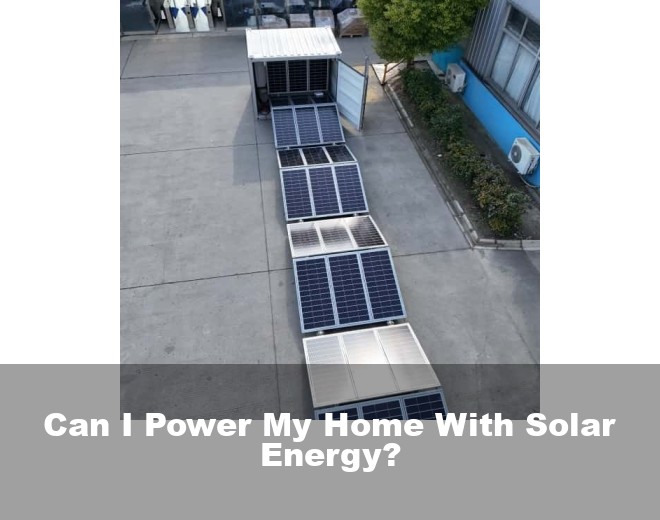Can I Power My Home With Solar Energy?

Table of Contents
The Solar Power Feasibility Check
You're probably wondering—can solar energy really power my entire home? Well, here's the kicker: In 2023, over 12 million American households answered that question with rooftop installations. But let's cut through the hype. The real answer depends on three critical factors:
First, your location's solar irradiance. Take Germany—a country with 40% less sunlight than Arizona—yet they generate 10% of national electricity from solar. Second, your roof's orientation and shading. Third (and this one surprises most people), your willingness to pair panels with smart energy habits.
Understanding Energy Consumption Patterns
The average U.S. home uses about 10,600 kWh annually. Now picture this: A 6kW solar system in Texas produces roughly 9,000 kWh yearly. Close, but not quite enough. That's where battery storage systems enter the equation, storing excess daytime energy for nighttime use.
Wait, no—it's not just about capacity. Modern homes have variable loads. Your AC might guzzle 3,500W on summer afternoons while LED lights sip 10W. Smart energy management can reduce peak demand by 30%, making solar-only operation more achievable.
The California Case Study
Let's look at San Diego. With 266 sunny days/year and tiered electricity rates hitting $0.45/kWh, homeowners there achieve full energy independence using:
- 8-10kW solar arrays
- 13.5kWh lithium batteries
- Smart thermostats and load-shifting
Battery Storage: The Missing Puzzle Piece
Remember when solar systems couldn't work during blackouts? Those days are gone. Today's hybrid inverters and modular batteries create resilient microgrids. A typical 10kWh battery (enough for overnight needs) costs $8,000-$12,000—but prices dropped 18% last year alone.
Here's where it gets interesting: Tesla's latest Powerwall 3 stores 13.5kWh while providing seamless backup. Combined with solar, such systems can power essential loads for 3-7 days during grid outages. Not bad for something the size of a flat-screen TV!
Solar Economics in Real-World Scenarios
Let's crunch numbers. A 8kW system in Florida costs $19,200 after federal tax credits. With monthly savings of $150 and 25-year panel lifespan, you're looking at 8-10 year payback. But wait—what if electricity rates keep climbing 4% annually? That payback period shrinks to 6 years by 2030.
Now consider Germany's approach. Their feed-in tariff system lets homeowners sell excess power at premium rates. While the U.S. favors net metering, 23 states now offer battery incentives—a game-changer for solar-plus-storage adopters.
Debunking Common Solar Myths
Myth #1: "Solar doesn't work in cold climates." Actually, photovoltaic cells operate more efficiently below 77°F. Minnesota—not exactly the Sunshine State—ranks top 15 in U.S. solar capacity.
Myth #2: "Maintenance costs will bankrupt me." Modern systems need just bi-annual cleaning and occasional inverter checks. Rain handles most cleaning, and microinverters eliminate single-point failures.
Your Solar Readiness Checklist
Before taking the plunge:
- Analyze 12 months of utility bills
- Get a professional shade assessment
- Compare local incentives (30% federal tax credit expires in 2034!)
- Consider future EV purchases or home expansions
Q&A: Quick Solar Insights
Q: Can I go completely off-grid?
A: Technically yes, but most homeowners maintain grid connection for reliability.
Q: Do solar panels increase home value?
A: Studies show 4.1% average premium, with faster sales in eco-conscious markets.
Q: How long do batteries last?
A: Quality lithium batteries offer 10-year warranties with 70%+ capacity retention.
Related Contents

AC Unit Solar Power: Revolutionizing Home Cooling with Renewable Energy
Did you know air conditioning accounts for 12% of U.S. household energy use? That's like leaving 15 light bulbs on 24/7! As temperatures keep breaking records - remember last month's 122°F (50°C) heatwave in India? - our reliance on AC units grows. But here's the kicker: conventional systems are sort of trapped in a vicious cycle. The more we cool our homes, the more we heat the planet through power plant emissions.

Solar Power Solar Energy: The Engine of Modern Energy Revolution
We've all heard the promise: solar energy could power the world 100 times over. But why then does Germany, a country with less annual sunshine than Alaska, lead in solar power adoption? The answer lies not in the quantity of sunlight, but in how we harness and store it.

Solar Energy, Wind Power, and Water Power Are Reshaping Our Energy Future
Let's face it—the energy transition isn't some distant future scenario anymore. Solar energy installations grew 35% year-over-year globally in 2023, while wind power accounted for 8% of Europe's electricity mix last winter. And get this: hydropower still provides over 60% of Brazil's electricity. But wait, aren't we supposed to be phasing out old tech? Well, that's where things get interesting.

2025 Sets Solar Power: Colorado Solar Energy Trade Shows
You know how people say the sun shines brighter in Colorado? Well, they're not just talking about the weather. With solar power installations jumping 43% since 2020, the Centennial State's becoming America's renewable energy lab. The upcoming Colorado solar energy trade shows in 2025 aim to showcase this transformation – but why should you care?

A House Using Solar Power Hydro Power and Wind Power
Ever opened your utility bill and felt that sinking dread? You’re not alone. The average U.S. household spends $1,500 annually on electricity—money that literally goes up in smoke. Now picture this: What if your home could generate its own power using solar panels, a mini hydro turbine, and a wind generator? No more grid dependency, no more rate hikes.




 Inquiry
Inquiry Online Chat
Online Chat